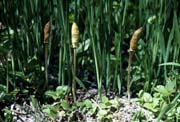
© Steve Trudell
Pacific Northwest Key Council does not intend to create keys for the underground fungi known as truffles and false truffles. The fourth reference below contains detailed keys to the genera of truffles and false truffles in the Pacific Northwest and is online at
http://www.fs.fed.us/pnw/pubs/pnw_gtr772.pdf
The North American Truffling Society, based in Corvallis, Oregon, has also collected keys on this group of fungi, including a trial key to Rhizopogon. The website of the North American Truffling Society is http://www.natruffling.org . Oregon is particularly wealthy in genera and species of truffles, and research is ongoing, especially at Oregon State University and the Forest Service.
The word truffle covers various ascomycete genera that develop spores in the interior of the fruitbody, most often underground. False truffles are similar fungi that are basidiomycetes. (They develop their spores on microscopic basidia instead of developing them in microscopic asci.) The term sequestrate fungi covers both of these but also other fungi in which the spores are sequestered (secluded) from the exterior of the fruitbody until the fruitbody decays or is eaten by an animal. This definition would include many puffballs and earthstars. The term sequestrate may be restricted to taxa that have evolved from having exposed hymenia and forcibly discharged spores, but determining exactly which species would fit that definition would be difficult. It is true however that some sequestrate genera are known to be related to specific non-sequestrate genera and presumably evolved their characters to adapt to specific environments.
Some sequestrate fungi develop above ground and are not considered truffles or false truffles for that reason. Podaxis pistillaris, Agaricus deserticola (=Longula texensis), Montagnea arenarius and Chlorophyllum agaricoides (=Endoptychum agaricoides) are not normally considered false truffles – they are covered in the “Desert Fungi”. Another is Leratiomyces cucullatus (=Weraroa cucullata), with a yellow to tawny, narrowly conic cap, brown to reddish brown contorted gills, slender yellow to tawny stem, growing among grasses in wet alpine meadows.
Leratiomyces cucullatus © Steve Trudell |
The following books are excellent resources for truffles and false truffles.
Castellano, M., James M. Trappe, Zane Maser, and Chris Maser. 1989. Key to Spores of the Genera of Hypogeous Fungi of North Temperate Forests with special reference to animal mycophagy. Illustrated by Jackie Atzet, Wendy Madar, & Gretchen Bracher. Mad River Press, Eureka.
Trappe, Matt, Frank Evans and James Trappe. 2005. NATS Field Guide To Selected North American Truffles and Truffle-like Fungi Published and distributed by the North Americal Truffling Society, Corvallis, Oregon.
Trappe, Matt, Frank Evans, and James Trappe. 2007. Field Guide To North American Truffles Hunting, Identifying, and Enjoying the World’s Most Prized Fungi. Ten Speed Press, Berkeley.
Trappe, James M., Randy Molina, Daniel L. Luoma, Efrén Cázares, David Pilz, Jane E. Smith, Michael A. Castellano, Steven L. Miller, and Matthew J. Trappe. 2009, April. Diversity, Ecology, and Conservation of Truffle Fungi in Forests of the Pacific Northwest. United States Department of Agriculture. Forest Service. Pacific Northwest Research Station. General Technical Report. PNW-GTR-772.
Since the publication of the fourth reference, the close genetic relationship between underground and above-ground genera has been accepted to the extent that many truffles have been renamed into the genus of the related above-ground genus. Examples are the following:
Macowanites, Gymnomyces, Cystangium → Russula
Gastrolactarius → Lactarius
Thaxterogaster → Cortinarius
Amogaster viridigleba → Lepiota viridigleba
Brauniellula albipes → Chroogomphus albipes
Nivatogastrium nubigenum → Pholiota nubigena
Endoptychum depressum → Agaricus inapertus
Gastroboletus → Boletus (not all)
Gastrosuillus → Suillus
Radiigera → Geastrum
New truffle or false truffle species since the fourth reference include Geopora cercocarpi, Kalapuya brunnea, Lepiota geophana, Paurocotylis bynumii, Tuber beyerlei, and Tuber lauryi.
Pachyphloeus species in the Pacific Northwest have been moved to Pachyphlodes.
Alpova alexsmithii has been moved to Rhizopogon.